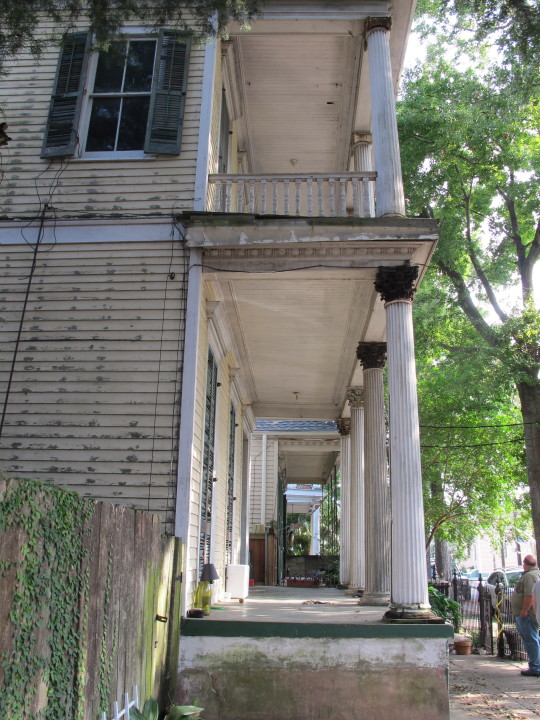
For years, my partner, Debbie, and I had been trying to decide where to someday settle down, as if settling down was even possible. We weren’t going to stay in Chicago because of the cold, with both of us lean and perpetually frozen. Beautiful and vibrant Paris and Barcelona were frontrunners for a while, but our desire to be close to family and my fear of flying made Europe unfeasible. Still, I call Amtrak every year to ask if the tracks are in, to which they reply: “Is this Craig?”
We love Seattle and Vancouver but felt we needed a little more sunshine. Sedona, with its geologic grandeur and rich Native American heritage beckoned, but the absence of children negated the village I longed to be a part of. Debbie had a fondness for Florida, but with the exception of Miami, it too smacked of being a place where old people go to die.
The one town that seemed to have it all—village, sunshine, vibrancy, and beauty, not to mention gumbo, jambalaya, and shrimp etouffée (did I mention food?) was New Orleans, where we’d been vacationing for years. With all signs pointing toward the party that never ends, we packed our bags and headed south, eager to scout the city’s neighborhoods.
The French Quarter was too touristy and expensive, the Garden District too sedate. One neighborhood in particular captured our attention with its mix of young and old, black and white, artists and musicians—all living amidst hole-in-the-wall eateries dotting every block. Sprawling along the Mississippi River, the neighborhood called the Bywater boasted one particular venue we’d already come to like—the Country Club, which isn’t a country club at all. Originally a gay resort launched in the 1980s, the Country Club is a historic home with two dining rooms, kitchen, and bar fronting a backyard paradise with a salt water pool, in-ground hot tub, sauna, and tiki bar nestled among towering palm trees and thick clusters of bamboo. In the early 2000s, women discovered the Country Club, and not to be deprived, took the place by storm. Today, couples of all orientations kiss discretely in the pool surrounded by hundreds of sun worshippers reveling on the playground.
Years before Debbie and I settled on the Bywater, a friend had driven me through the neighborhood, declaring that the street we were on, Clouet Street, was the best street in town. A block later, a house drew my attention. I turned and pointed. “Look at that!” I said. “Forget about it,” he retorted. “I’ve been after that house for years.”
Debbie and I began our search by enlisting the help of local realtor, Kat Bosio, a young and beautiful professional with a quick mind, expensive car, and rock star boyfriend to drive us through the Bywater. In particular, I asked her to cruise Clouet Street—“the best street”—and neighboring Louisa where the Country Club is located. Every time she passed a house that made our eyes bulge and hearts race, I yelled, “THAT one! I’d pay too much for THAT one!” Repeatedly, Kat screeched to a halt and scribbled down addresses. “But none of these are for sale,” she said. “Doesn’t matter,” I replied. “Write the owners letters and see what happens.”
Kat emailed me her letter a few days later. I read it and sent a revised copy back, telling her hers made her sound too much like a realtor: “If you ever decide to sell, I have customers who …” I suggested instead that she name Debbie and me and say we were visiting from Chicago, house hunting in the neighborhood, and went wild when we passed their house. “If there’s some crazy amount of money for which you’d be willing to sell, call me, or call Craig and Debbie directly at …”
Kat called a month later sounding dejected because no one had responded. “Of course not,” I said, “with a sample size of eight!” I thanked her for her efforts and told her not to worry. With her help, we’d eventually find something.
Another month passed. The phone rang while I was under the hairdryer at a beauty parlor, primping for an annual party Debbie and I were hosting in Chicago. Kat sounded out of breath and excited. Between pants, she told me a man had just called whose father had recently died and the family wanted to sell the house. He’d gone there for the first time in months to gather the mail and found Kat’s letter along with two others from other realtors. He read all three and called her first.
Adrenaline surging, I asked the price and looked up the address on the Internet. “That’s not all,” Kat said. “The lot’s double wide and double deep. It’s one of the biggest properties in the Bywater! And it has PARKING!” “Call him back,” I said. “Tell him I just bought his house and I’ll be driving down in the morning to pick it up. Twenty-four hours later, I shook hands with John Fontenelle, and Kat started the process rolling.
On the day of closing, I stood on the front porch of the run-down, yet dripping-with-potential Civil-War-era plantation house with upper and lower galleries and majestic fluted columns and shook my head, wondering how such a thing was possible—being able to buy one of eight hand-selected houses, none of which was for sale! I took a few pictures and crossed the street to take a few more. From that perspective, it suddenly dawned on me. The house I’d just purchased was none other than the one that had turned my head, capturing my imagination years before.